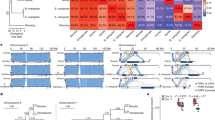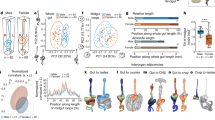Abstract
The ‘bobbed’ (bb) mutation in Drosophila is represented phenotypically by shortened and abnormally thin scutellar bristles and by delayed development. There is a direct correlation between bristle size and ribosomal RNA (rRNA) synthesis1, and the bb mutation was at first explained as a deficiency of rRNA genes (rDNA)2. However, the bb phenotype can occur in Drosophila melanogaster1 and Drosophila hydei3 with high rDNA content, while phenotypically wild-type flies are known with few rRNA genes, suggesting that what matters is not the number of rRNA genes but their transcriptional activity. In D. melanogaster, it has recently emerged that rRNA genes interrupted by an intervening sequence are not transcribed4. We now report that in D. hydei, the length of the scutellar bristle is directly proportional to the number of rRNA genes without this intervening sequence.
This is a preview of subscription content, access via your institution
Access options
Subscribe to this journal
Receive 51 print issues and online access
$199.00 per year
only $3.90 per issue
Buy this article
- Purchase on Springer Link
- Instant access to full article PDF
Prices may be subject to local taxes which are calculated during checkout
Similar content being viewed by others
References
Shermoen, A. W. & Kiefer, B. I. Cell 4, 275–280 (1975).
Ritossa, F. M., Atwood, K. C. & Spiegelman, S. Genetics 54, 819–834 (1966).
Schäfer, U. & Kunz, W. Heredity 37, 351–355 (1976).
Long, E. O. & Dawid, I. B. Cell 18, 1185–1196 (1979).
Hennig, W., Link, B. & Leoncini, O. Chromosoma (Berl.) 51, 57–63 (1975).
Schäfer, U. & Kunz, W. Molec. gen. Genet. 137, 365–368 (1975).
Kunz, W., Petersen, G., Renkawitz-Pohl, R., Glätzer, K. H. & Schäfer, M. Chromosoma (Berl.) (in the press).
Glätzer, K. H. Chromosoma (Berl.) 75, 161–175 (1979).
Southern, E. M. J. molec. Biol. 98, 503–517 (1975).
Renkawitz-Pohl, R., Glätzer, K. H. & Kunz, W. Nucleic Acids Res. 8, 4593–4611 (1980).
Hennig, W. & Meer, B. Nature new Biol. 233, 70–72 (1971).
Renkawitz, R. & Kunz, W. Chromosoma (Berl.) 53, 131–140 (1975).
Grimm, C. & Kunz, W. Molec. gen. Genet. 180, 23–26 (1980).
Spear, B. B. & Gall, J. G. Proc. natn. Acad. Sci. U.S.A. 70, 1359–1363 (1973).
Overton, J. J. Morph. 122, 367–380 (1967).
Kunz, W. & Schäfer, U. Genetics 82, 25–34 (1976).
Spencer, W. P. Genetics 29, 520–536 (1944).
Beck, H. Drosoph. Inf. Serv. 50, 94–95 (1973).
Gall, J. G., Cohen, E. H. & Polan, M. L. Chromosoma (Berl.) 22, 319–344 (1971).
Mulder, M. P., van Duijn, P. & Gloor, H. J. Genetica 39, 385–428 (1968).
van Breugel, F. M. A. Genetica 41, 589–625 (1970).
Author information
Authors and Affiliations
Rights and permissions
About this article
Cite this article
Franz, G., Kunz, W. Intervening sequences in ribosomal RNA genes and bobbed phenotype in Drosophila hydei. Nature 292, 638–640 (1981). https://doi.org/10.1038/292638a0
Received:
Accepted:
Issue Date:
DOI: https://doi.org/10.1038/292638a0
This article is cited by
-
Genetic factors affecting normal growth of testes inDrosophila hydei
Wilhelm Roux's Archives of Developmental Biology (1985)
-
The organ-specific rRNA gene number in Drosophila hydei is controlled by sex heterochromatin
Chromosoma (1984)
-
Ribosomal RNA contents of maize genotypes with different ribosomal RNA gene numbers
Biochemical Genetics (1984)
-
Regulation of ribosomal RNA synthesis in Drosophila melanogaster cells with different contents of sex chromosomes and nucleolar organizers
Molecular and General Genetics MGG (1983)
-
Determination of the region of rDNA involved in polytenization in salivary glands of Drosophila hydei
Molecular and General Genetics MGG (1983)
Comments
By submitting a comment you agree to abide by our Terms and Community Guidelines. If you find something abusive or that does not comply with our terms or guidelines please flag it as inappropriate.



